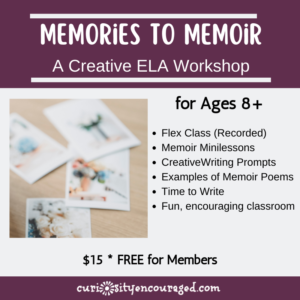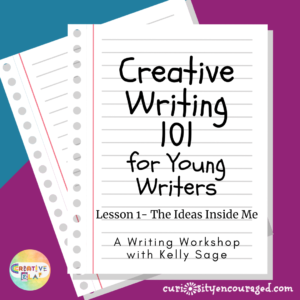“Curiosity, asking questions, not getting the right answer, deciding to find out for yourself, making a mistake and not giving up and learning patience. It was all there when I was 4 and a half.” ~ Jane Goodall
In an interview on Startalk, Jane Goodall spoke about being a curious child. She said her mother took the time to listen to her, “A different kind of mother might have crushed that scientific curiosity, and maybe I wouldn’t have done what I’ve done.”
Goodall brings up an essential truth. Children have what they need to learn at a very early age. We are born explorers and curiosity is a powerful guide. But, we don’t go at it alone. In fact, I bet most successful adults would say they had a parent or mentor who helped and encouraged them. It makes a difference, having someone to talk to, someone who listens, and who thinks what you’re interested in is important.
I try to be the kind of mother, parent, and teacher Goodall refers to; someone who takes the time to listen, who puts down the phone, closes the computer, and directs my full attention to the child who needs me to see this cool bug RIGHT NOW! It’s not easy. Even with want and the best intentions, a child’s constant need to know can be overwhelming. Maybe we feel like we don’t have enough time to stop and look or maybe we have zero interest in our child’s interests. Sometimes long to-do lists and busy days can take precedence over play and exploration.
Like most things, I’ve found encouraging our children’s curiosity is a practice. We can tune in or out, make time or say maybe later, and sometimes it comes down to priorities, choice, and paying attention to distractions.
~ We can stop and listen to questions and wonderings.
~ We can help our children find answers.
~ We can notice their interests, nurture them, guide, offer them opportunities to dig in deeper.
To help us, I’ve gathered 100 different ways to encourage curiosity. Some are as simple as sitting with a child and listening. Some require a little bit of planning.
There are MANY ways to encourage curiosity.
The important part is we are.
Looking for baby resources or ways to encourage curiosity with little, little ones- check out Thinkbaby! Full of ideas, tips, and encouragement- Thinkbaby has your little kiddos in mind!
100 ways to Encourage Curiosity
Reading
1. Make reading out loud a part of your family’s every day. Bedtime isn’t the only time to share in story. Read together during meals, car rides, or before transitions. (Audiobooks and podcasts are helpful during these times.)
2. 50 Great Reads for Your Teen
3. When We Let Our Children Read- We Grow Readers.
4. How to Find a Just Right Book
5. Greek Mythology- Books and Movies Your Kids will Love
6. Keep books your kids love on hand, on the coffee table, in the car, on a Kindle, anywhere they spend time. The best way to encourage reading is by reading, so make sure when the opportunity arises, they have a book to read.
8. Starting Project Based Learning with Aesop’s Fables– Adventures in Mommydom
9. Use the public library! Give yourself and your children plenty of time to browse. Look for books that mirror your children’s interests. Ask them what they’d love to learn about this week. Check out books they might enjoy and then strew them around the house or create a big pile on the floor. There is something about a pile of anything- children are like magnets.
10. Don’t forget about magazines, comic books, zines, podcasts, audiobooks, cookbooks, signs, menus, manuals, etc. There are many ways to engage a reader.
Writing
11. Simple Ways to Play with Words
12. A Writing Territories List- Inspiration and Encouragement for Writers
13. Let your child see you writing, talk about writing, talk about people you know who write. Steer away from the mentality that only some people are writers. Make writing seem as normal and valuable as learning to drive.
14.Throw out red pens and the need to fix or make a child’s writing perfect. The quickest way to stifle a writer is to tell them everything that is wrong.
15. Keep plenty of paper, and writing utensils strewed around the house. Bring journals hiking, in the car, and on vacation.
16. Read with your kids! Writers are readers!
17. Allow your child to focus on tapping into their creativity, getting their ideas on the page, and their enjoyment of writing. Being a good editor will come with time. Being good at spelling and grammar is pretty pointless if you hate writing and never write. Offer gentle ways to help them with spelling and grammar.
18. Check out NaNoWriMo Young Writers Program
19. If you’re in Indiana or Ohio check out Young Women Writing for (a) Change
20. Play writing games!
Math
21. Help Children Love Math When You Don’t
22. Play Math Games!
23. Help your child create a Math Handbook filled with everything they are leaning and need to remember.
24. Learn math in the kitchen. Cook with your kids and once they’re ready, let them make dinner.
25. Successful Entrepreneur- 3 Best Homeschooling Teen Resources– Tina’s Dynamic Homeschool
26. Loving Living Math– Curriculum Choice
27. Play MORE Math Games! Math and Games go hand in hand!
28. Check out Khan Academy, Beast Academy, and ABC Mouse
29. Learn how to Code with Make Wonder Robots
30. Use math manipulatives and tools to make math hands-on and meaningful.
Science
31. Cook, try making up some Edible Chemistry, get outside, explore national and state parks.
32. Try a Groovy Lab in a Box
33. Play Science Games! Totally Gross is one of our favorites!
34. Explore science with Kiwi Co boxes. We love Kiwi and Tinker!
35. 6 Ways to Engage Your Child in Nature-Based Play– Rule This Roost
36. Interest-Based Ocean Study– Our Journey Westward
37. Resources for Putting the Technology in STEM– Blog, She Wrote
38. Adventures in Chemistry– Blog, She Wrote
39. Cultivating Curiosity with Nature Study– Hodgepodge
40. Do NOT Teach Science (Today)– Homeschooling without Training Wheels
History
41. Play History Games!
42. Check out the Best History Books for kids.
43. National Geographic Education
44. PBS Learning
46. Digital Public Library of America
49. History Pin– Local History
50. Hands-on History Through Creative Play– Raising Life Long Learners
art & Music
51. How to Start Art with Young Children– Hodgepodge
52. Strew art supplies on the table. Maybe watercolors one day and clay the next.
53. Go to art museums. Take sketchpad. Explore, find inspiration, and create your masterpieces.
54. Search yard sales, rent, borrow, or buy instruments and let kids play with them. Find classes, workshops, or get kids together and let them jam.
55. Take an online art class together.
56. Check out books from the library on different artists and invite children to mimic their style.
57. Listen to different kinds of music! In the car, at home, in the evenings. Let kids rummage through your old albums, tapes, and CDs. Have impromptu dance parties.
58. Keep a basket of musical instruments and things that can make music (bells, shakers, flutes, chimes) somewhere kids can easily access them.
59. National Gallery of Art for kids
60. National Association of Music Education
Geography & Travel
71. Take a Vacation into the Little House Series
72. Junior Ranger Programs- Explore National Parks with Children
73. Day Hiking with Children- Essential Gear
74. Bring an Adventurer’s Journal along on your travels.
75. Spin a globe. See where it takes you. Go to the library, look for documentaries, find cookbooks, grab an atlas. Travel and learn by reading, cooking, and sharing the cool facts you find.
76. Grab “old fashion” maps or let your kids hold the GPS and take a car trip. Let them navigate or follow along as you travel.
77. Geography Quests– Blog, She Wrote
78. Adventures in Sailing, Exploration, and Navigation– Blog, She Wrote
79. The Passport Club- Give Them the World– Curriculum Choice
80. Hands on Geography for Multiple Ages– Hodgepodge
And More
81. How to Nurture a Love of Learning
83. How to Kill Your Child’s Curiosity in Six Easy Steps– Bethany Ishee
84. 3 Simple Ways to Ignite Imagination in Your Elementary Age Child– Not So Formulaic
85. Exploring for Creativity– Homeschooling with Tea
86. Removing Distraction to Inspire Creative Play– Some Random Lady
87. Is it Nothing to be Happy– Brain Power Boy
88. Showing a Child the World is Fascinating– Sallie Borrink
89. Exploring Leads to Learning– Brain Power Boy
90. Why You Need to Cultivate Curiosity in Your Children– Walking By the Way
91. Let your kids see you being creative – get out the art supplies or the puppets or the legos and model what it’s like to dive in with no plan. Talk out loud about your thinking as you invent and create on the fly. Lindsay- Let Me Give You Some Advice
92. Take turns choosing books, movies, activities after dinner or on weekends. Make an agreement that even if the chooser chooses something others aren’t into, everyone will give it a chance and have a good attitude.
93. Have kids make a list of all the things they hope to do and learn in a given season or year. Like goal setting, a bucket learning list is a great motivator because it plants a seed. There are a couple of bucket list printables available for subscribers.
94. Provocations – (based on Reggio Emilia philosophy) set out things that will intrigue your kids without instructions or even a set agenda. Let them explore materials or books and then follow up with some questions. Nothing gets kids curious faster than not having the answers. Lindsay- Let Me Give You Some Advice
95. If a child is interested in something, even if you already know about the subject or could care less, be interested. Ask questions: Can you tell me more about that? What do you love about _______? or I don’t know much about ________, what do you know? And listen to what they know. Try to avoid interrupting with your facts. Those can wait until after they are finished.
96. Offer creative challenges. Fun challenges make them think outside the box and build up some creativity resilience when things don’t go as planned. Lindsay- Let Me Give You Some Advice
97. Be mindful about turning everything into a lesson or learning. Yes, in everything there are lessons and learnings, but naming it can take a child out of the learning and make them less interested.
98. Talk to your kids about your interests, challenges, learnings, what you love. If you see or read something interesting, share it. Again, curiosity is contagious.
99. As long as they will be safe, let kids stumble and try things (even if you know they aren’t going to work out). Let them find their truth and answers. Let them learn.
100. Join me in seeking, searching, playing, and encouraging the love of learning.
 Looking for more resources?! On November 6th, The iHomeschool Network will feature 100 Things posts about all sorts of wonderful subjects! Be sure to check them out.
Looking for more resources?! On November 6th, The iHomeschool Network will feature 100 Things posts about all sorts of wonderful subjects! Be sure to check them out.




















Oh my word, what a treasure trove! Pinned this for my early childhood education major daughter. She’ll be thrilled! 🙂 Stopping by from Love to Learn!
Thanks so much!!
These are such wonderful ideas!! Pinned.
Thank you! So glad you stopped by 🙂
Thanks for such a fabulous list of resources!
Thanks for stopping by, Eva!
Pingback: 100 Things: a Treasure Trove of Ideas for Family and Home - KidMinds